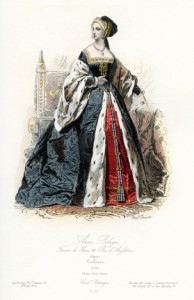 On Easter Eve, Saturday 12th April 1533, Anne Boleyn attended mass in the Queen’s Closet of Greenwich Palace “with all the pomp of a Queen, clad in cloth of gold, and loaded (carga) with the richest jewels.”1 This was her first public appearance since her husband, Henry VIII, had informed his council the previous day that Anne was to be recognised as his wife and queen, and afforded royal honours, and it was quite a spectacle.
On Easter Eve, Saturday 12th April 1533, Anne Boleyn attended mass in the Queen’s Closet of Greenwich Palace “with all the pomp of a Queen, clad in cloth of gold, and loaded (carga) with the richest jewels.”1 This was her first public appearance since her husband, Henry VIII, had informed his council the previous day that Anne was to be recognised as his wife and queen, and afforded royal honours, and it was quite a spectacle.
Eustace Chapuys, the imperial ambassador, wrote:
“On Saturday, Easter Eve, dame Anne went to mass in Royal state, loaded with jewels, clothed in a robe of cloth of gold friese. The daughter of the duke of Norfolk, who is affianced to the duke of Richmond, carried her train; and she had in her suite 60 young ladies, and was brought to church, and brought back with the solemnities, or even more, which were used to the Queen. She has changed her name from Marchioness to Queen, and the preachers offered prayers for her by name. All the world is astonished at it for it looks like a dream, and even those who take her part know not whether to laugh or to cry.
The King is very watchful of the countenance of the people, and begs the lords to go and visit and make their court to the new Queen, whom he intends to have solemnly crowned after Easter, when he will have feastings and tournaments; and some think that Clarencieux went four days ago to France to invite gentlemen at arms to the tourney, after the example of Francis, who did so at his nuptials. I know not whether this will be before or after, but the King has secretly appointed with the archbishop of Canterbury that of his office, without any other pressure, he shall cite the King as having two wives; and upon this, without summoning the Queen, he will declare that he was at liberty to marry as he has done without waiting for a dispensation or sentence of any kind.”2
On this same day, Henry VIII received a letter from Thomas Cranmer, the newly consecrated Archbishop of Canterbury, “Beseeching the King very humbly to allow him to determine his great cause of matrimony.”3 The King replied, giving him “licence” to do so.4 This meant that Cranmer could open a special trial into the annulment proceedings, which he did at Dunstable Priory, Bedfordshire. On 23rd May 1533, the court declared Henry’s marriage to Catherine “to be against the law of God” and dissolved it.5 The King had married Anne Boleyn on 25th January 1533 and this marriage was declared valid on 28th May 1533, just days before Anne’s coronation.
Also on 12th April 1533, Thomas Cromwell was made Chancellor of the Exchequer: “Thos. Crumwell. To be chancellor of the Exchequer, with the fees, robes, and vesture belonging to the office, from the death of Sir John Bourghchier lord Berners, who lately held it.”6
Notes and Sources
- Calendar of State Papers, Venice, iv. 870.
- Letters and Papers, Foreign and Domestic, Henry VIII, Volume 6, 1533, 351.
- Ibid., 327.
- Ibid., 332.
- Ibid., 525, Letter from John Tregonwell to Cromwell, 23rd May 1533.
- Ibid., 417 Grants in April 1533, 22.